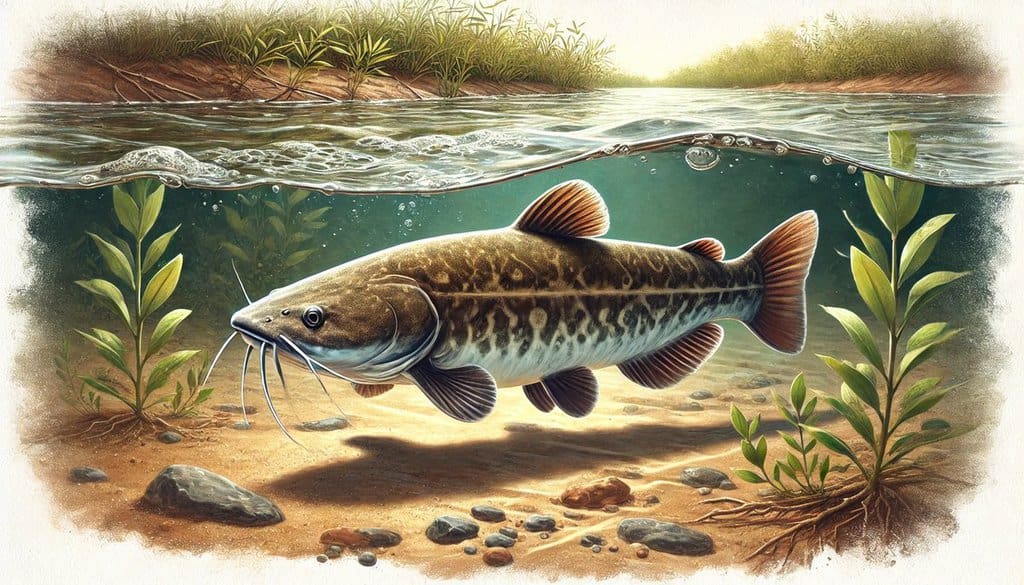The Flathead Catfish is a popular species for aquaponics due to its hardiness, impressive growth rate, and excellent taste. This large catfish species is known for its voracious appetite and ability to thrive in various water conditions, making it an attractive option for aquaponics enthusiasts[1][3].
Natural Habitat and Behavior
Origin and native environment: Flathead catfish are native to large rivers and their major tributaries in the Mississippi, Missouri, and Ohio basins, extending from southern Canada to northeastern Mexico[2][3]. They prefer long, slow-flowing, moderately turbid streams with deep pools[3].
Natural behavior in the wild: Adult flatheads are solitary and spend most of their time in deep water near cover such as log jams or fallen trees[3]. They are primarily nocturnal, often feeding at the surface or in shallow water at night and returning to their resting spots during the day[3].
Temperament: In aquaponics systems, flathead catfish can be territorial and may exhibit aggressive behavior, especially as they grow larger[1].
Compatibility: Due to their predatory nature and large size, flathead catfish are generally not suitable for keeping with other fish species in aquaponics systems[2].
Water Requirements
Temperature Range: The ideal temperature range for flathead catfish is 18-29°C (65-84°F)[4]. Temperatures below this range can slow down metabolism and food consumption, potentially reducing nutrient availability for plants in the aquaponics system[4].
pH Level: Flathead catfish prefer a pH range of 6.0-7.5[1].
Water hardness: They can tolerate a wide range of water hardness levels but prefer moderately hard water[1].
Oxygen Levels: Ideal oxygen levels for flathead catfish are 4-5 ppm (parts per million)[4]. Extra aeration may be required when temperatures exceed 29°C (85°F) or in densely stocked tanks[4].
Ammonia/Nitrate Sensitivity: Like most catfish species, flatheads are relatively tolerant of higher ammonia and nitrate levels, but maintaining good water quality is crucial for their health and growth[1].
Tank or Pond Setup
Tank/Pond Size Requirements: Due to their large size potential, flathead catfish require spacious tanks or ponds. A general rule is to provide at least 100 liters (26 gallons) of water per kilogram (2.2 pounds) of fish[4].
Filtration & Aeration: Strong filtration and aeration are necessary to maintain water quality and oxygen levels, especially in densely stocked systems[4].
Lighting Considerations: Flathead catfish prefer dimly lit environments, mimicking their natural habitat[2].
Tank Decorations/Substrate: Provide hiding spots such as large rocks, driftwood, or artificial structures to mimic their natural environment and reduce stress[3].
Feeding Requirements
Diet: Flathead catfish are carnivorous predators. In the wild, they primarily feed on live fish, insects, annelid worms, and crustaceans[2]. In aquaponics systems, they can be fed a diet of commercial catfish pellets supplemented with live or frozen fish[1].
Feeding Techniques: Feed adult flathead catfish 1-2 times daily, offering about 2.5% of their body weight in food[4]. Younger fish may require more frequent feeding.
Supplements or special diets: High-protein diets are essential for optimal growth. Supplementing with live prey occasionally can help mimic their natural diet[2].
Growth and Reproduction
Growth Rate: Flathead catfish grow rapidly, potentially reaching 1.4-2.3 kg (3-5 lbs) in their first year under optimal conditions[1].
Physical Growth Indicators: As they mature, flathead catfish develop a more pronounced flat head and projecting lower jaw. Their coloration may become more mottled with dark brown or black patterns[2].
Breeding Behavior: Spawning occurs in late spring or early summer when water temperatures reach 21-26°C (70-80°F)[3]. In aquaponics systems, breeding can be challenging due to space requirements and specific environmental needs.
Care of Fry: If breeding is successful, fry should be separated from adults to prevent cannibalism. They can be fed newly hatched brine shrimp or commercial fry food[1].
Harvesting & Culinary Considerations
Growth to Harvest: Flathead catfish typically reach harvestable size of 0.45-1.8 kg (1-4 lbs) in 12-18 months[1].
Culinary Uses: The meat is white, firm, and flaky with an excellent taste. It’s highly regarded as a food fish when taken from clean water[3].
Pros and Cons
- Rapid growth rate
- Tolerance to varying water conditions
- Excellent food conversion ratio
- High-quality, tasty meat
- Require large system size due to their growth potential
- Predatory nature limits compatibility with other fish species
- May be challenging to breed in captivity
Overall Suitability: Flathead catfish are best suited for experienced aquaponics practitioners with large-scale systems, particularly those focused on food production rather than ornamental purposes.
Common Health Issues and Solutions
Potential Diseases: Flathead catfish can be susceptible to common catfish diseases such as columnaris and ich. Stress from poor water quality or overcrowding can increase disease susceptibility[1].
Signs of Health Issues: Look for changes in behavior, loss of appetite, visible lesions, or abnormal swimming patterns[1].
Treatment Recommendations: Maintain excellent water quality and proper nutrition to prevent most health issues. If diseases occur, consult with a fish health specialist for appropriate treatments[1].
Maintenance Tips for Long-Term Health
Maintenance Frequency: Regular water quality testing and system checks are crucial. Perform partial water changes as needed to maintain optimal conditions[4].
System checks: Monitor temperature, pH, ammonia, nitrite, and nitrate levels regularly. Ensure proper functioning of filtration and aeration systems[4].
Handling Practices: Minimize handling to reduce stress. When necessary, use wet hands or nets to move fish[1].
Winter/Summer Care: In outdoor systems, ensure adequate depth to prevent freezing in winter. Provide additional aeration during hot summer months[3].
Closing Thoughts
Flathead catfish can be an excellent choice for large-scale aquaponics systems due to their rapid growth and tasty flesh. However, their size and predatory nature present some challenges. Successful cultivation requires careful planning, spacious setups, and attentive management. For those with the right resources and experience, raising flathead catfish can be a rewarding endeavor in aquaponics.
More fish species for aquaponics
External sources:
[1] https://afspubs.onlinelibrary.wiley.com/doi/10.1002/nafm.10654
[2] https://animalia.bio/index.php/flathead-catfish
[3] https://www.fs.usda.gov/Internet/FSE_DOCUMENTS/fsbdev3_018530.pdf
[4] https://www.howtoaquaponic.com/fish/catfish-aquaponics/
[5] https://animaldiversity.org/accounts/Pylodictis_olivaris/
[6] https://tpwd.texas.gov/huntwild/wild/species/catfish/
[7] https://www.researchgate.net/publication/351919973_Two_Decades_of_Advancement_in_Flathead_Catfish_Research

